The Importance of Spatial Resolution in the Modeling of Methane Emissions from Natural Wetlands
Abstract
:1. Introduction
2. Materials and Methods
2.1. Hypothetical Experiment
2.2. Wetlands CH4 Model
2.3. Study Area and Data
Study Area
2.4. Data
2.4.1. Wetland Map
2.4.2. Organic Soil Carbon SOC
2.4.3. Soil Moisture SM
2.4.4. Temperature T
2.4.5. Q10 and KCH4
3. Results
3.1. Scenario Sn.1
3.2. Scenario Sn.2
3.3. Scenario Sn.3
3.4. Scenario Sn.4-a and Sn.4-b
4. Discussion
5. Conclusions
Author Contributions
Funding
Data Availability Statement
Acknowledgments
Conflicts of Interest
Appendix A
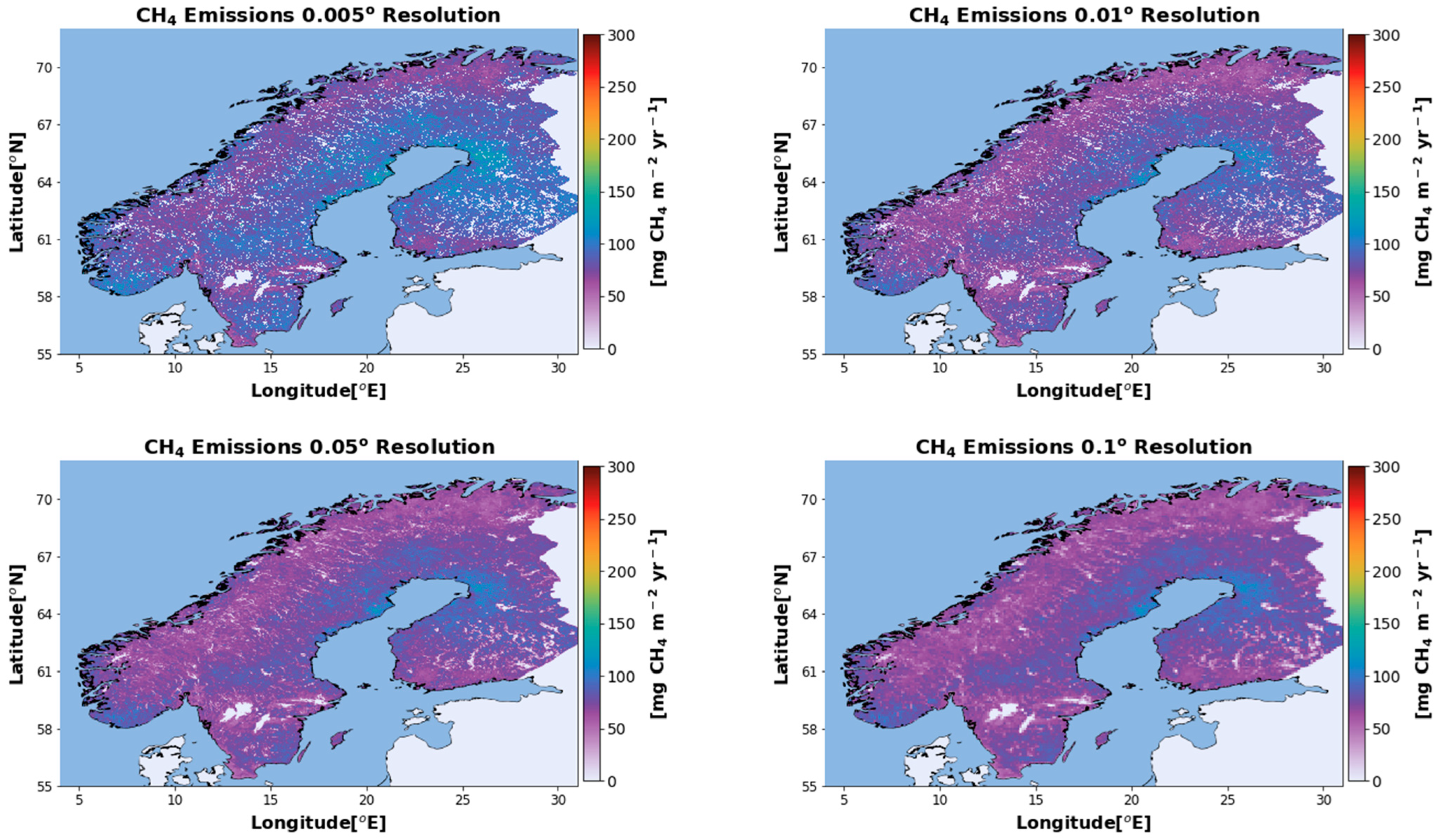


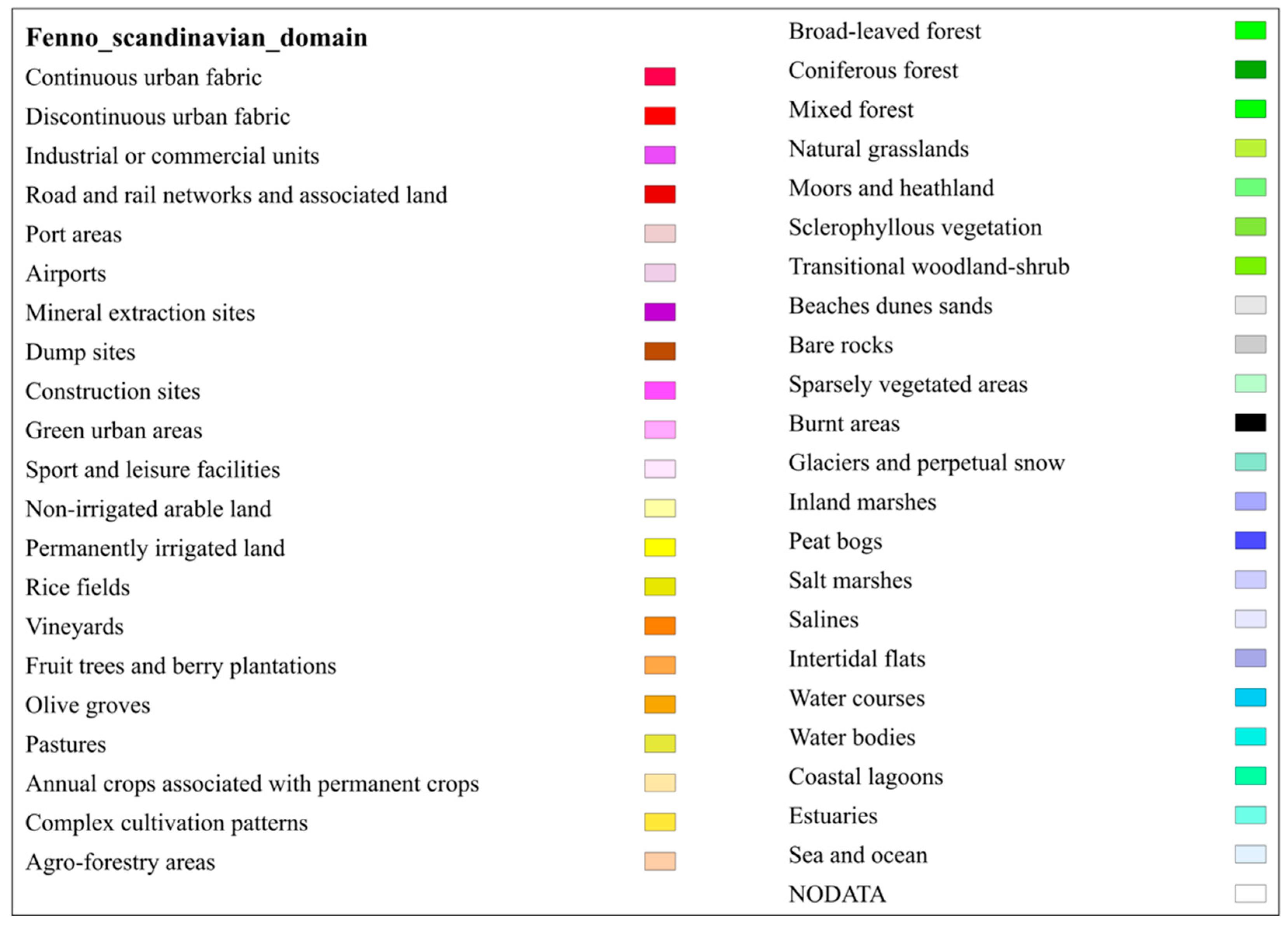
Appendix B
| Model | Wetland Determination Scheme | Original Resolution (lon × lat) | Principal References |
|---|---|---|---|
| LPJ-Bern | Prescribed peatlands and monthly inundation. Simulated dynamic wet mineral soils (saturated, non-inundated). | 0.5° × 0.5° | Spahni et al. [29] |
| LPJ-WHyMe | Prescribed peatland extents with simulated saturated/unsaturated conditions. | 0.5° × 0.5° | Wania et al. [9] |
| LPJ-WSL | Prescribed from monthly inundation dataset. | 0.5° × 0.5° | Zhen Zhang et al. [30] |
| ORCHIDEE | Mean yearly extent over 1993–2004 period scaled to that of inundation dataset with model calculated intra- and inter-annual dynamics. | 1.0° × 1.0° | Wania et al. [9] |
| SDGVM | Independently simulated extents. | 0.5° × 0.5° | Melton et al. [8], Singarayer et al. [9] |
| DLEM | Maximal extents from inundation dataset with simulated intra-annual dynamics. | 0.5° × 0.5° | Melton et al. [8] |
| GLWD-3 | Created on the basis of existing maps, data, and information, such as the Digital Chart of the World, World Conservation Monitoring Centre (WCMC) and others. | 30 arc-s (0.008° × 0.008°) | Lehner et al. [31] |
| GIEMS | Satellite based inundated surface data for each month for 15 years (1993–2007) for each pixel on the globe. | 0.25° × 0.25° | Prigent et al. [32] |
References
- Saunois, M.; Stavert, A.R.; Poulter, B.; Bousquet, P.; Canadell, J.G.; Jackson, R.B.; Raymond, P.A.; Dlugokencky, E.J.; Houweling, S. The Global Methane Budget 2000–2017. Earth Syst. Sci. Data 2020, 1561–1623. [Google Scholar] [CrossRef]
- IIPCC2013. Climate Change 2013—The Physical Science Basis; Climate Change 2013; IPCC: Geneva, Switzerland, 2013; ISBN 9781107661820. [Google Scholar]
- IPCC Climate Change 2007 Synthesis Report. Intergovernmental Panel on Climate Change; IPCC: Geneva, Switzerland, 2007. [Google Scholar]
- Anthony Bloom, A.; Bowman, W.K.; Lee, M.; Turner, J.A.; Schroeder, R.; Worden, R.J.; Weidner, R.; McDonald, C.K.; Jacob, J.D. A Global Wetland Methane Emissions and Uncertainty Dataset for Atmospheric Chemical Transport Models (WetCHARTs Version 1.0). Geosci. Model Dev. 2017, 10, 2141–2156. [Google Scholar] [CrossRef]
- Bloom, A.A.; Bowman, K.; Lee, M.; Turner, A.J.; Schroeder, R.; Worden, J.R.; Weidner, R.; McDonald, K.C.; Jacob, D.J. A Global Wetland Methane Emissions and Uncertainty Dataset for Atmospheric Chemical Transport Models. Geosci. Model Dev. Discuss. 2016, 1–37. [Google Scholar] [CrossRef]
- Silvey, C.; Jarecke, K.M.; Hopfensperger, K.; Loecke, T.D.; Burgin, A.J. Methane and Nitrous Oxide Emissions from Natural Sources. In Emissions of Methane and Nitrous Oxide from Natural Sources; Nova Science Publishers, Inc.: Hauppauge, NY, USA, 2012; pp. 1–196. ISBN 9781620816448. [Google Scholar]
- Kirschke, S.; Bousquet, P.; Ciais, P.; Saunois, M.; Canadell, J.G.; Dlugokencky, E.J.; Bergamaschi, P.; Bergmann, D.; Blake, D.R.; Bruhwiler, L.; et al. Three Decades of Global Methane Sources and Sinks. Nat. Geosci. 2013, 6, 813–823. [Google Scholar] [CrossRef]
- Melton, J.R.; Wania, R.; Hodson, E.L.; Poulter, B.; Ringeval, B.; Spahni, R.; Bohn, T.; Avis, C.A.; Beerling, D.J.; Chen, G.; et al. Present State of Global Wetland Extent and Wetland Methane Modelling: Conclusions from a Model Inter-Comparison Project (WETCHIMP). Biogeosciences 2013, 10, 753–788. [Google Scholar] [CrossRef]
- Wania, R.; Melton, J.R.; Hodson, E.L.; Poulter, B.; Ringeval, B.; Spahni, R.; Bohn, T.; Avis, C.A.; Chen, G.; Eliseev, A.V.; et al. Present State of Global Wetland Extent and Wetland Methane Modelling: Methodology of a Model Inter-Comparison Project (WETCHIMP). Geosci. Model Dev. 2013, 6, 617–641. [Google Scholar] [CrossRef]
- Matthews, E.; Fung, I. Methane Emission from Natural Wetlands: Global Distribution, Area, and Environmental Characteristics of Sources. Global Biogeochem. Cycles 1987, 1, 61–86. [Google Scholar] [CrossRef]
- Zhang, Z.; Zimmermann, N.E.; Stenke, A.; Li, X.; Hodson, E.L.; Zhu, G.; Huang, C.; Poulter, B. Emerging Role of Wetland Methane Emissions in Driving 21st Century Climate Change. Proc. Natl. Acad. Sci. USA 2017, 114, 9647–9652. [Google Scholar] [CrossRef]
- Peltola, O.; Vesala, T.; Gao, Y.; Räty, O.; Alekseychik, P.; Aurela, M.; Chojnicki, B.; Desai, A.R.; Dolman, A.J.; Euskirchen, E.S.; et al. Monthly Gridded Data Product of Northern Wetland Methane Emissions Based on Upscaling Eddy Covariance Observations. Earth Syst. Sci. Data Discuss. 2019, 11, 1263–1289. [Google Scholar] [CrossRef]
- Zheng, B.; Zhang, Q.; Tong, D.; Chen, C.; Hong, C.; Li, M.; Geng, G.; Lei, Y.; Huo, H.; He, K. Resolution Dependence of Uncertainties in Gridded Emission Inventories: A Case Study in Hebei, China. Atmos. Chem. Phys. 2017, 17, 921–933. [Google Scholar] [CrossRef]
- Zhu, X.; Zhuang, Q.; Lu, X.; Song, L. Spatial Scale-Dependent Land-Atmospheric Methane Exchanges in the Northern High Latitudes from 1993 to 2004. Biogeosciences 2014, 11, 1693–1704. [Google Scholar] [CrossRef]
- Awuah, K.T. Effects of Spatial Resolution, Land-Cover Heterogeneity and Different Classification Methods on Accuracy of Land-Cover Mapping; Southern Swedish Forest Research Centre: Alnarp, Sweden, 2017. [Google Scholar] [CrossRef]
- Gedney, N.; Cox, P.M.; Huntingford, C. Climate Feedback from Wetland Methane Emissions. Geophys. Res. Lett. 2004, 31, 1–4. [Google Scholar] [CrossRef]
- Büttner, G.; Kostztra, B.; Soukup, T.; Sousa, A.; Langanke, T. CLC2018 Technical Guidelines; European Environment Agency: Copenhagen, Denmark, 2017; 60p.
- Faltan, V.; Petrovič, F.; Ot’ahel’, J.; Feranec, J.; Druga, M.; Hruška, M.; Nováček, J.; Solár, V.; Mechurová, V. Comparison of CORINE Land Cover Data with National Statistics and the Possibility to Record This Data on a Local Scale-Case Studies from Slovakia. Remote Sens. 2020, 12, 2484. [Google Scholar] [CrossRef]
- Kosztra, B.; Büttner, G.; Hazeu, G.; Arnold, S. Updated CLC Illustrated Nomenclature Guidelines; European Environment Agency: Copenhagen, Denmark, 2017; pp. 1–124.
- Hengl, T.; De Jesus, J.M.; Heuvelink, G.B.M.M.; Gonzalez, M.R.; Kilibarda, M.; Blagotić, A.; Shangguan, W.; Wright, M.N.; Geng, X.; Bauer-Marschallinger, B.; et al. SoilGrids250m: Global Gridded Soil Information Based on Machine Learning. PLoS ONE 2017, 12, e0169748. [Google Scholar] [CrossRef] [PubMed]
- Schaufler, G.; Kitzler, B.; Schindlbacher, A.; Skiba, U.; Sutton, M.A.; Zechmeister-Boltenstern, S. Greenhouse Gas Emissions from European Soils under Different Land Use: Effects of Soil Moisture and Temperature. Eur. J. Soil Sci. 2010, 61, 683–696. [Google Scholar] [CrossRef]
- Muñoz Sabater, J. ERA5-Land Monthly Averaged Data from 1981 to Present; Copernicus Climate Change Service (C3S), Climate Data Store (CDS): Brno, Czech Republic, 2019. [Google Scholar] [CrossRef]
- Sutanudjaja, E.H.; van Beek, L.P.H.; Drost, N.; de Graaf, I.E.M.; de Jong, K.; Peßenteiner, S.; Straatsma, M.W.; Wada, Y.; Wanders, N.; Wisser, D.; et al. PCR-GLOBWB 2.0: A 5 Arc-Minute Global Hydrological and Water Resources Model. Geosci. Model Dev. 2018, 11, 2429–2453. [Google Scholar] [CrossRef]
- Walter, B.P.; Heimann, M. A Process-Based, Climate-Sensitive Model to Derive Methane Emissions from Natural Wetlands: Application to Five Wetland Sites, Sensitivity to Model Parameters, and Climate. Global Biogeochem. Cycles 2000, 14, 745–765. [Google Scholar] [CrossRef]
- Ringeval, B.; De Noblet-Ducoudré, N.; Ciais, P.; Bousquet, P.; Prigent, C.; Papa, F.; Rossow, W.B. An Attempt to Quantify the Impact of Changes in Wetland Extent on Methane Emissions on the Seasonal and Interannual Time Scales. Global Biogeochem. Cycles 2010, 24, 1–12. [Google Scholar] [CrossRef]
- Gunnarsson, U.; Löfroth, M. The Swedish Wetland Survey—Compiled Excerpts From The National Final Report; Swedish Environmental Protection Agency: Stockholm, Sweeden, 2014; ISBN 9789162066185.
- Party, E.C.; Importance, I. The List of Wetlands of International Importance. Available online: https://www.ramsar.org/sites/default/files/documents/library/sitelist.pdf (accessed on 9 May 2023).
- Zhang, B.; Tian, H.; Lu, C.; Chen, G.; Pan, S.; Anderson, C.; Poulter, B. Methane Emissions from Global Wetlands: An Assessment of the Uncertainty Associated with Various Wetland Extent Data Sets. Atmos. Environ. 2017, 165, 310–321. [Google Scholar] [CrossRef]
- Spahni, R.; Wania, R.; Neef, L.; Van Weele, M.; Pison, I.; Bousquet, P.; Frankenberg, C.; Foster, P.N.; Joos, F.; Prentice, I.C.; et al. Constraining Global Methane Emissions and Uptake by Ecosystems. Biogeosciences 2011, 8, 1643–1665. [Google Scholar] [CrossRef]
- Zhang, Z.; Zimmermann, N.E.; Kaplan, J.O.; Poulter, B. Modeling Spatiotemporal Dynamics of Global Wetlands: Comprehensive Evaluation of a New Sub-Grid TOPMODEL Parameterization and Uncertainties. Biogeosciences 2016, 13, 1387–1408. [Google Scholar] [CrossRef]
- Lehner, B.; Döll, P. Development and Validation of a Global Database of Lakes, Reservoirs and Wetlands. J. Hydrol. 2004, 296, 1–22. [Google Scholar] [CrossRef]
- Prigent, C.; Jimenez, C.; Bousquet, P. Satellite-Derived Global Surface Water Extent and Dynamics Over the Last 25 Years (GIEMS-2). J. Geophys. Res. Atmos. 2020, 125, e2019JD030711. [Google Scholar] [CrossRef]
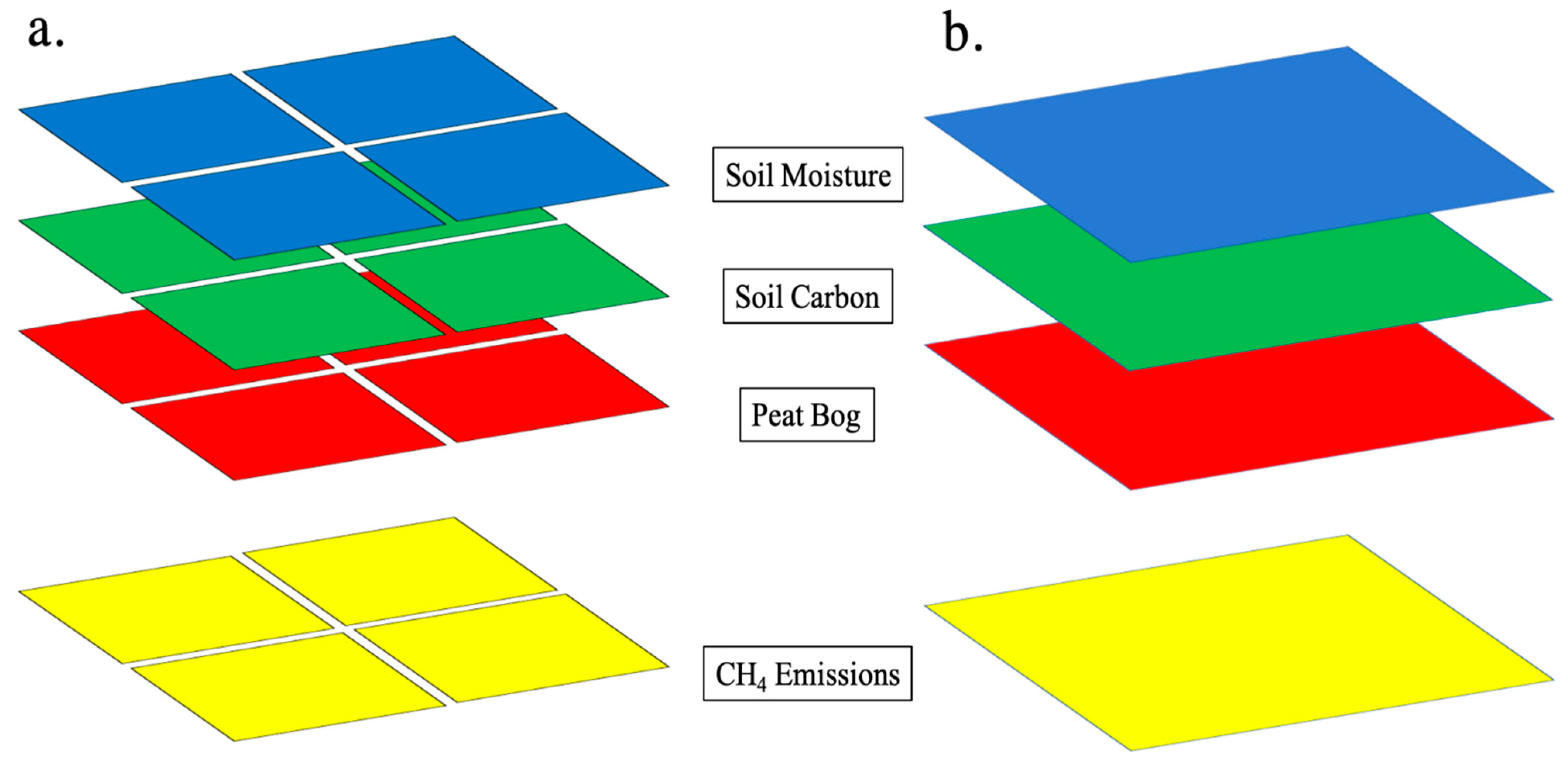
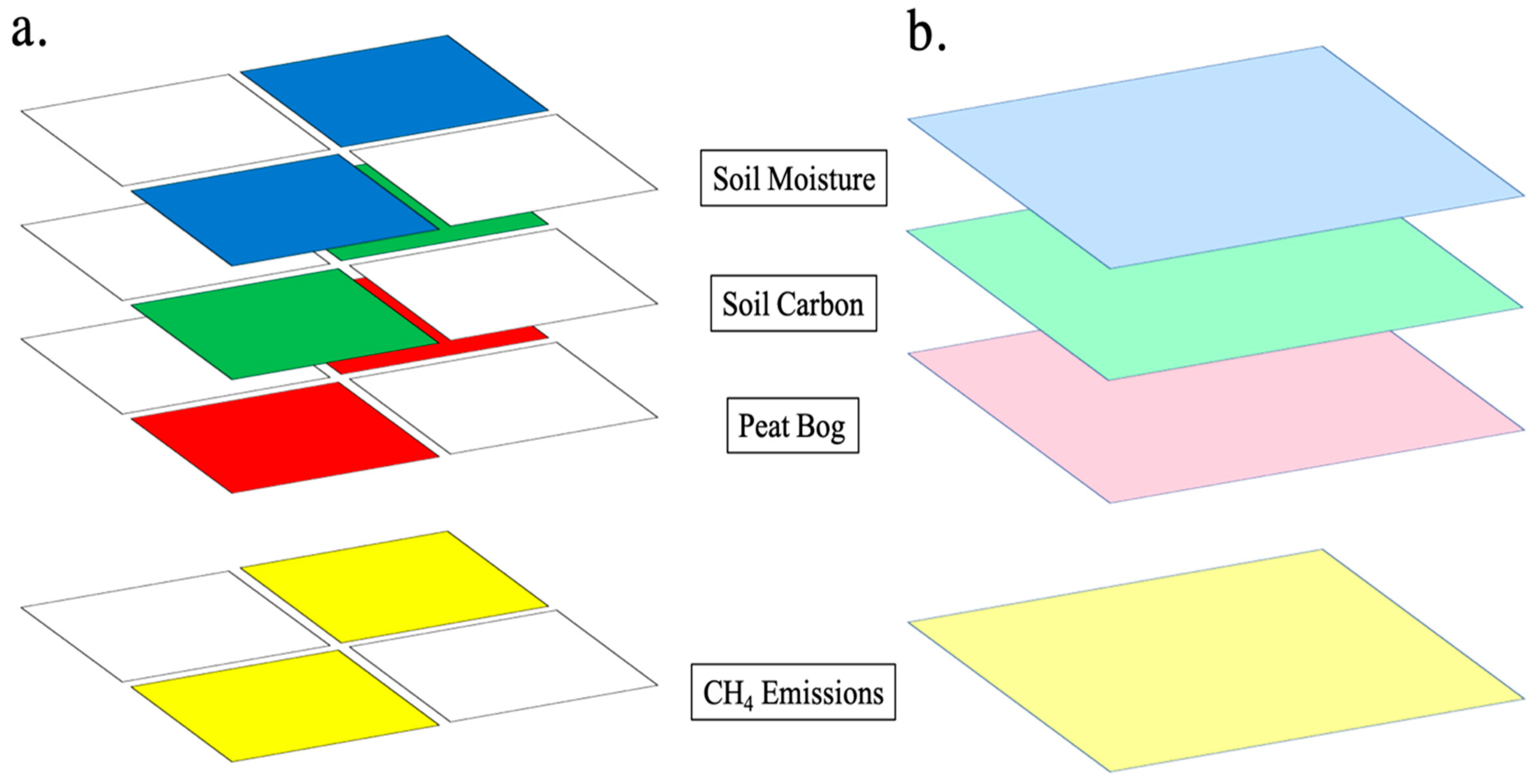
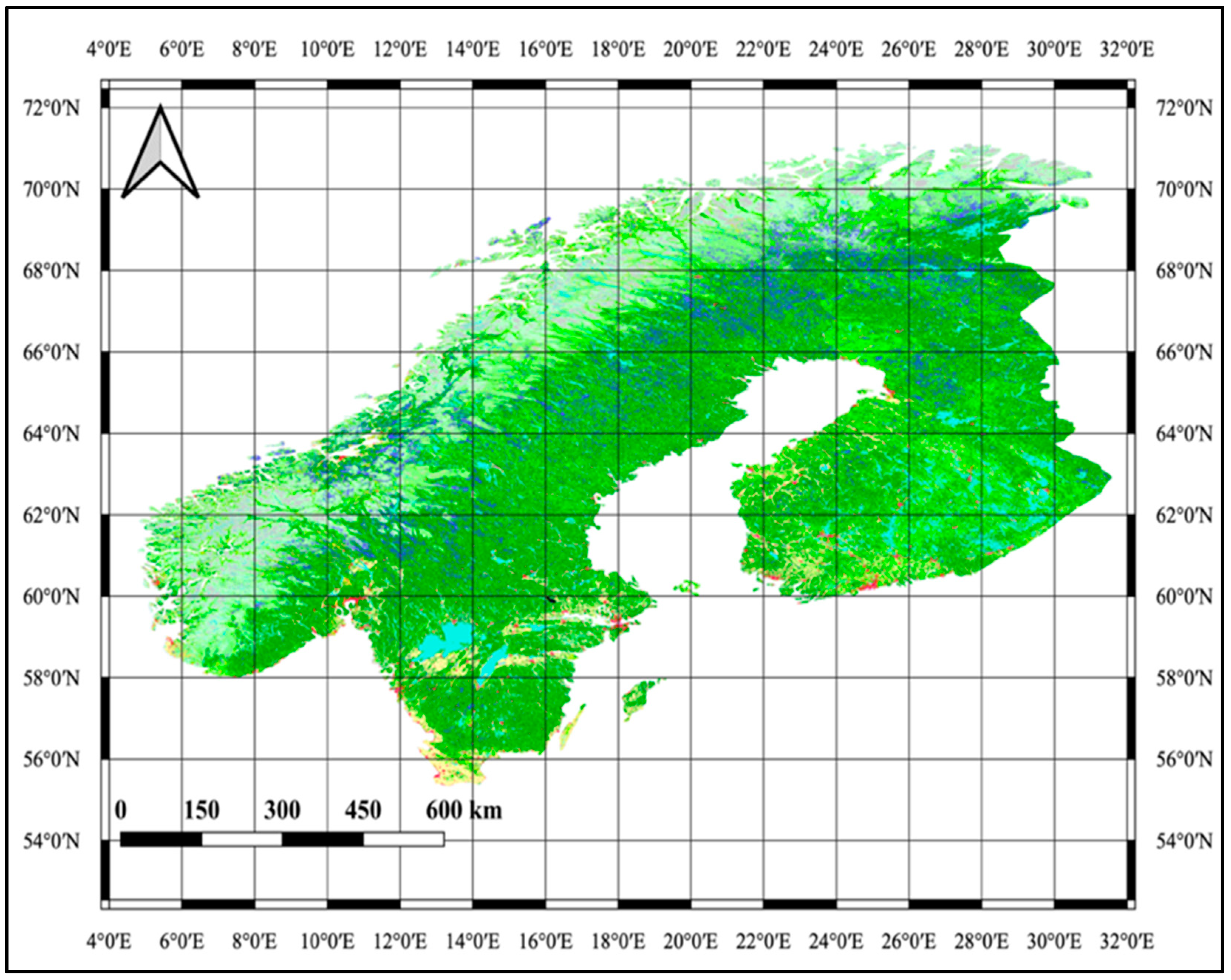
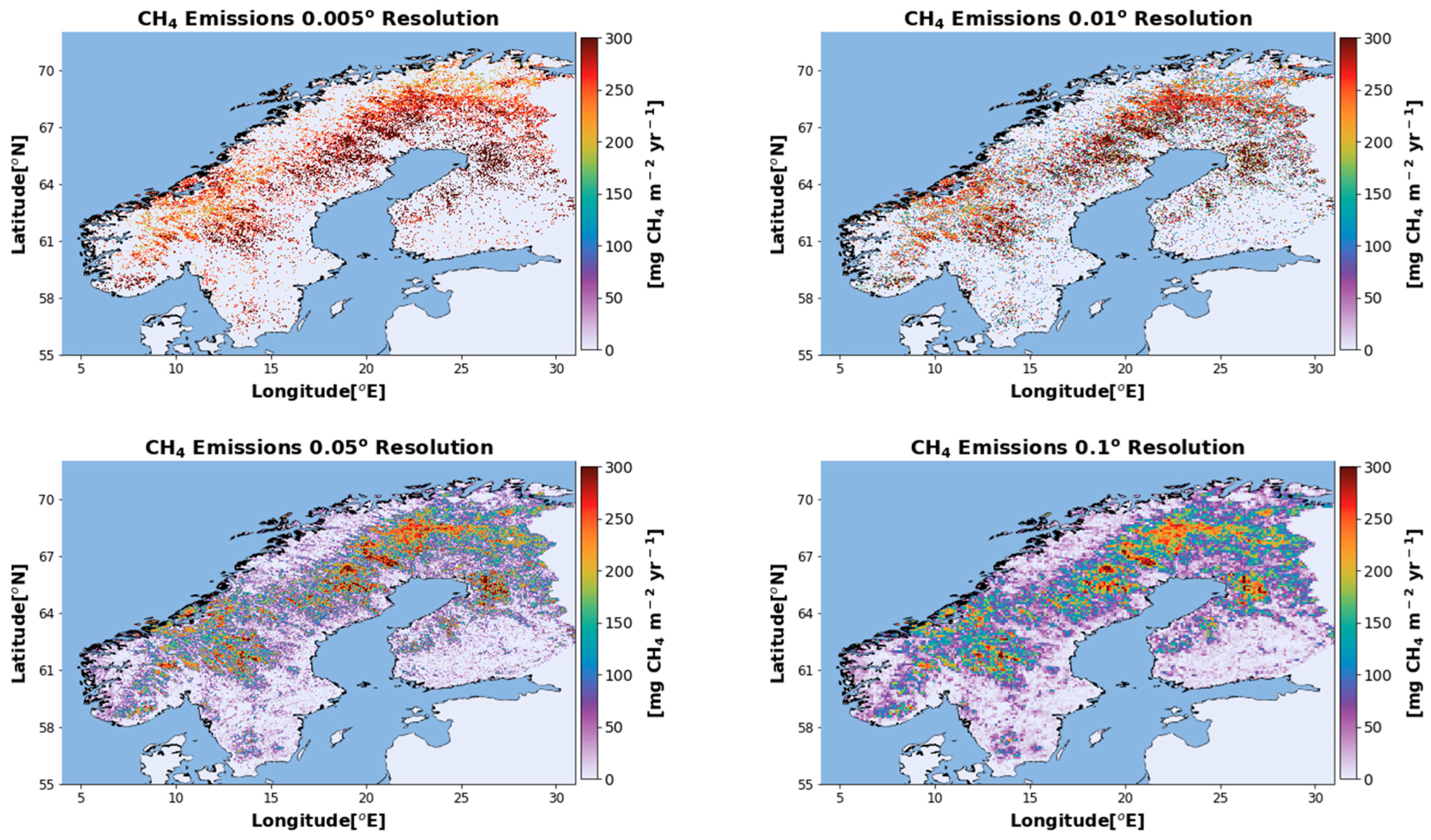

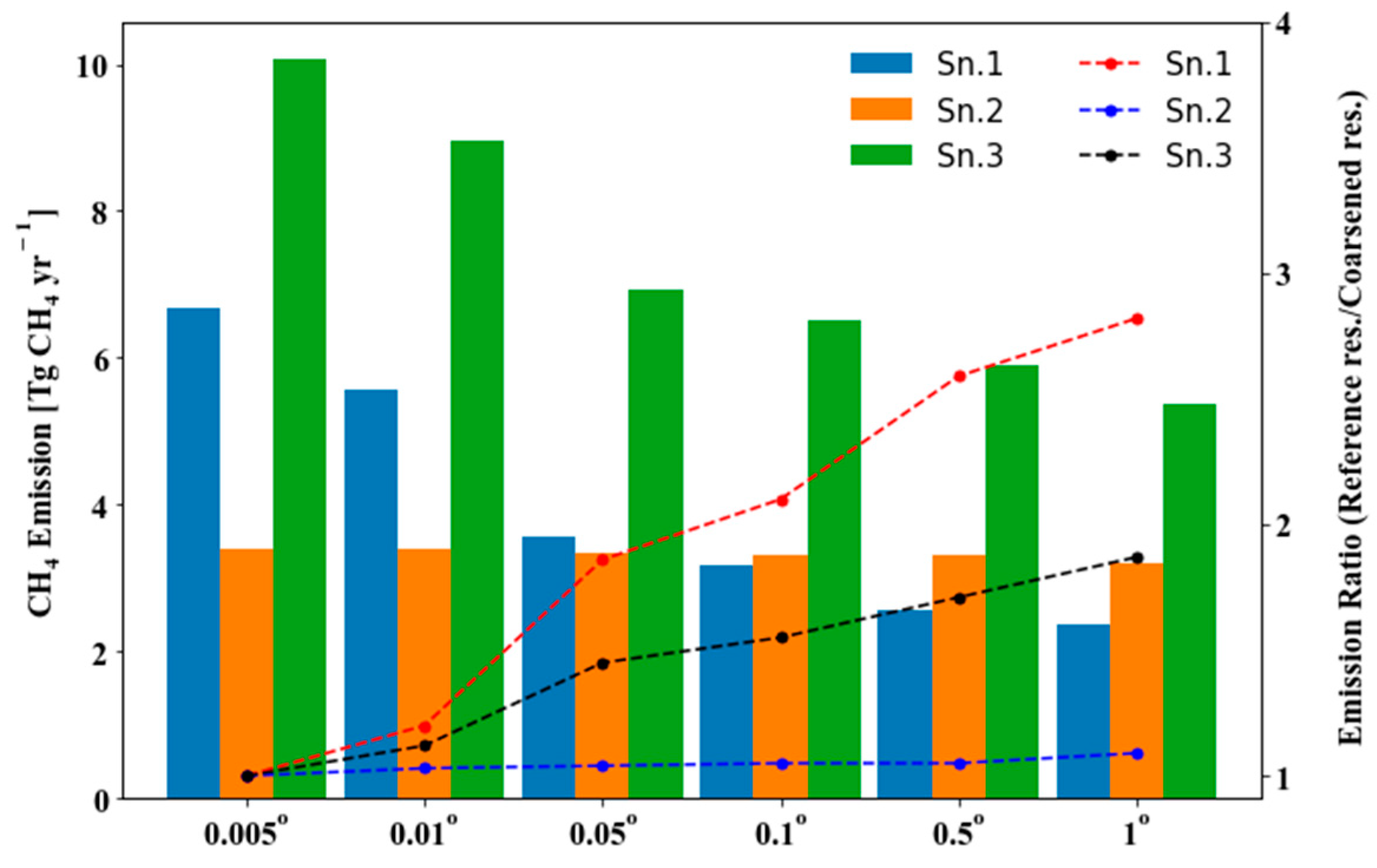
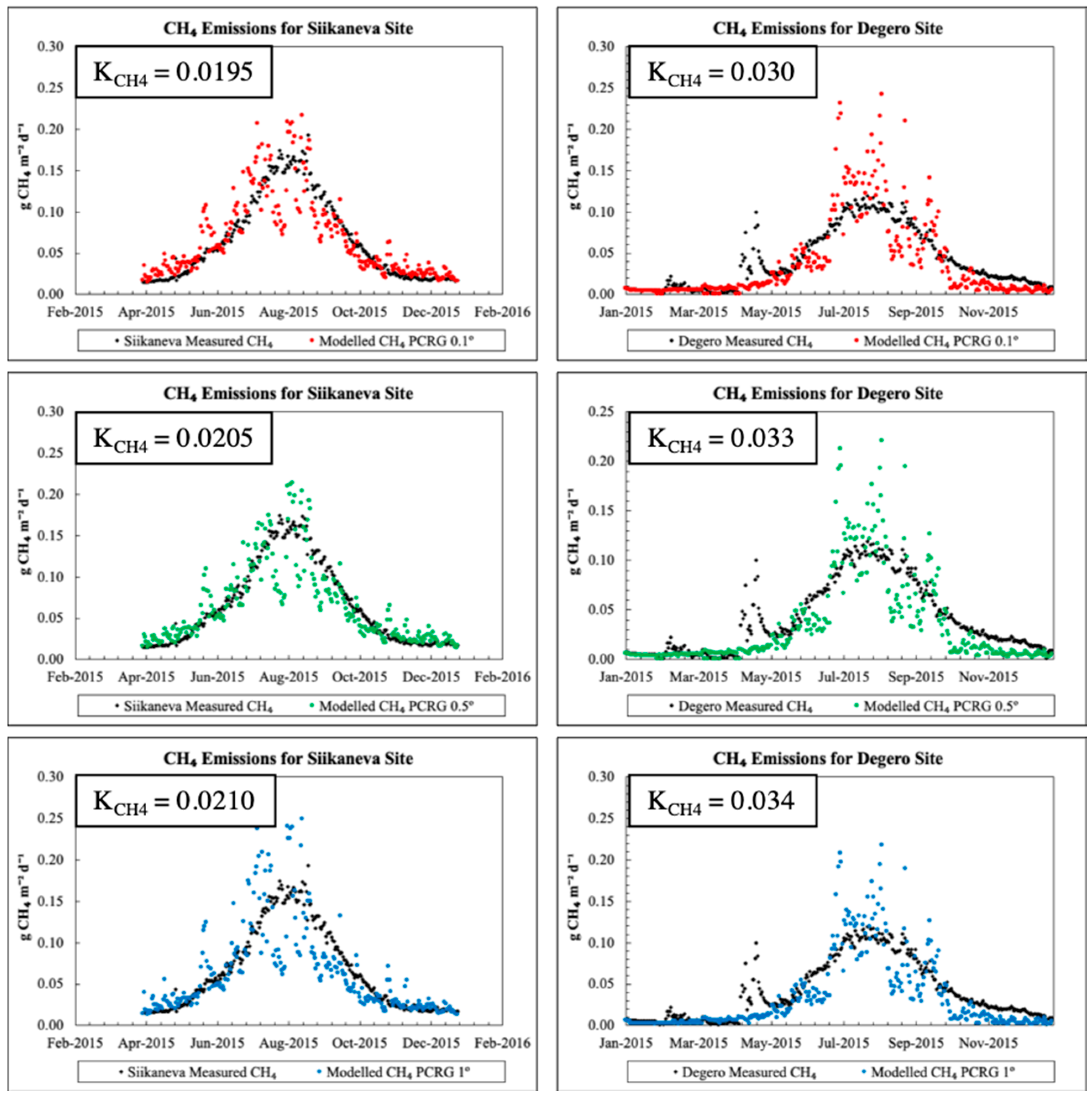
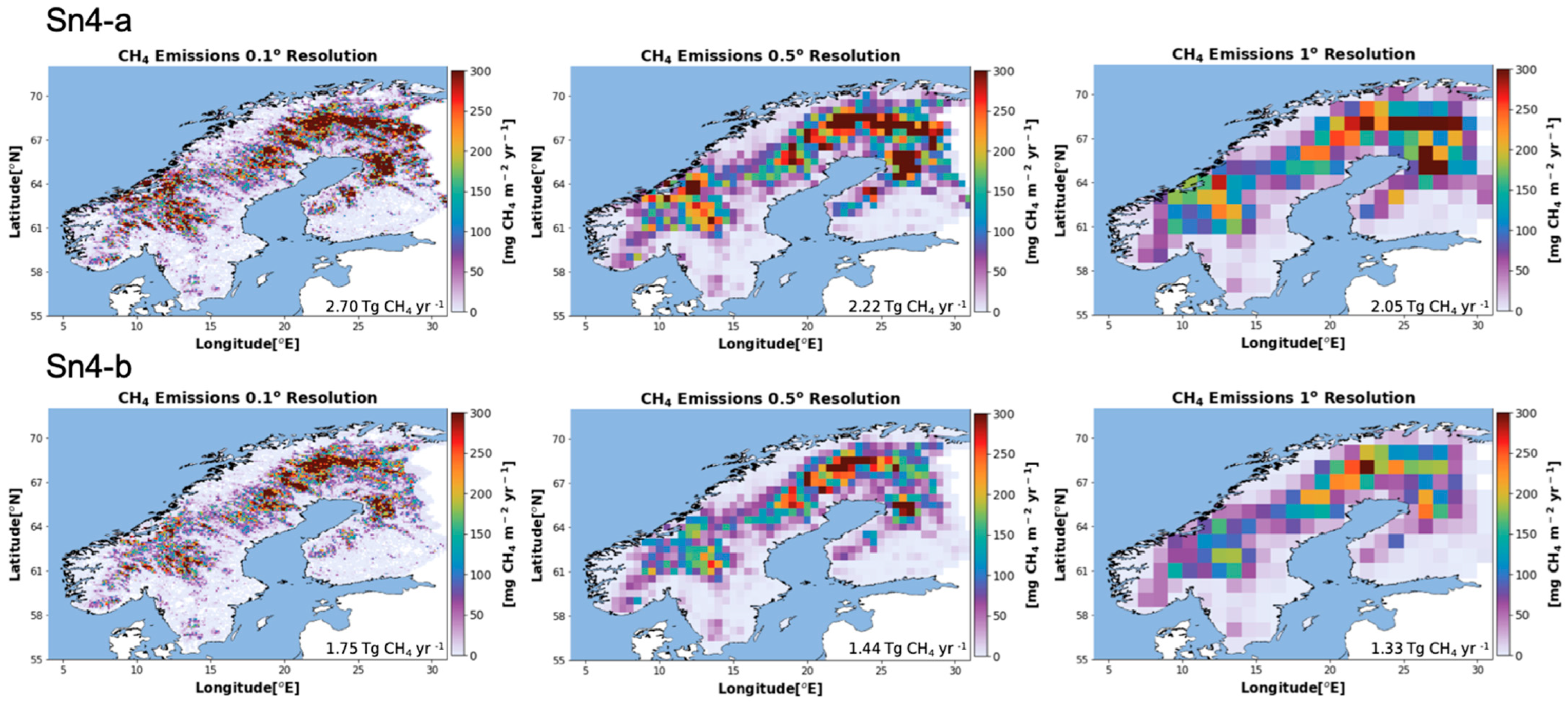
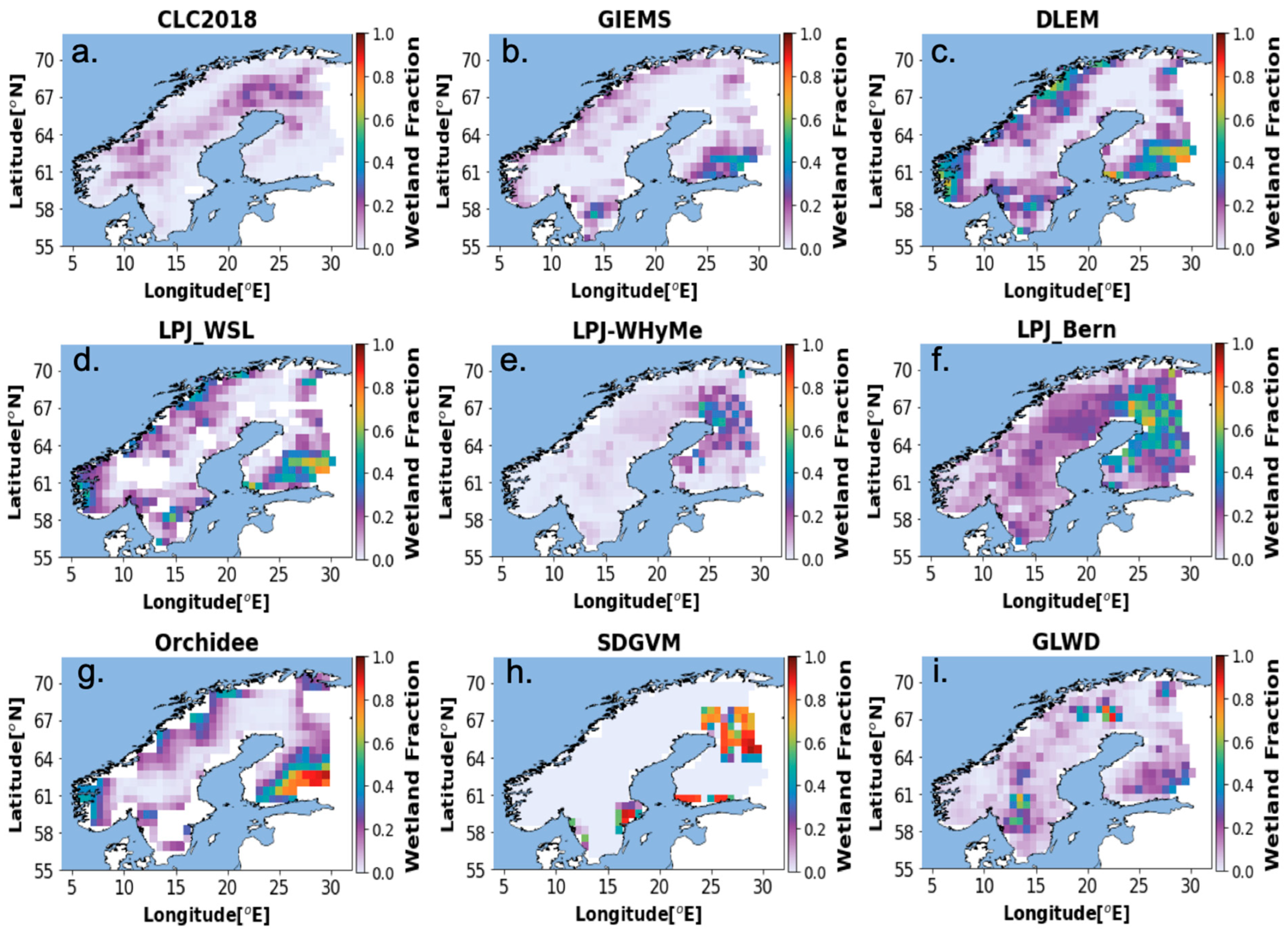


| Scenarios | Wetlands | Uplands | Temperature (K) | ||
|---|---|---|---|---|---|
| SOC (g.m−2) | SM (cm3.cm−3) | SOC (g.m−2) | SM (cm3.cm−3) | ||
| Sn.1 | ISRIC 2017 | 0.70 | ISRIC 2017 | 0 | ERA5 |
| Sn.2 | ISRIC 2017 | 0 | ISRIC 2017 | 0.25 | ERA5 |
| Sn.3 | ISRIC 2017 | 0.70 | ISRIC 2017 | 0.25 | ERA5 |
| Sn.4-a | ISRIC 2017 | ERA5 | ISRIC 2017 | 0 | ERA5 |
| Sn.4-b | ISRIC 2017 | PCRG | ISRIC 2017 | 0 | ERA5 |
| Site ID | Site Name | Country | Lat (°N) | Lon (°E) |
|---|---|---|---|---|
| FI-Siik | Siikaneva I | Finland | 61.83 | 24.19 |
| SE-Deg | Degero | Sweden | 64.18 | 19.56 |
| Integrated Methane Emissions over the Study Area | |||||||
|---|---|---|---|---|---|---|---|
| Scenarios | Resolution (°) | 0.005° | 0.01° | 0.05° | 0.1° | 0.5° | 1° |
| Sn.1 | Total Emissions (Tg CH4 yr−1) | 6.67 | 5.56 | 3.58 | 3.17 | 2.57 | 2.36 |
| CH4 (Ref. Resolution */Resolution **) | 1.00 | 1.30 | 1.86 | 2.10 | 2.59 | 2.82 | |
| Sn.2 | Total Emissions (Tg CH4 yr−1) | 3.4 | 3.39 | 3.36 | 3.33 | 3.32 | 3.21 |
| CH4 (Ref. Resolution */Resolution **) | 1.00 | 1.03 | 1.04 | 1.05 | 1.05 | 1.09 | |
| Sn.3 | Total Emissions (Tg CH4 yr−1) | 10.07 | 8.95 | 6.94 | 6.5 | 5.89 | 5.37 |
| CH4 (Ref. Resolution */Resolution **) | 1.00 | 1.12 | 1.45 | 1.55 | 1.71 | 1.87 | |
Disclaimer/Publisher’s Note: The statements, opinions and data contained in all publications are solely those of the individual author(s) and contributor(s) and not of MDPI and/or the editor(s). MDPI and/or the editor(s) disclaim responsibility for any injury to people or property resulting from any ideas, methods, instructions or products referred to in the content. |
© 2023 by the authors. Licensee MDPI, Basel, Switzerland. This article is an open access article distributed under the terms and conditions of the Creative Commons Attribution (CC BY) license (https://creativecommons.org/licenses/by/4.0/).
Share and Cite
Albuhaisi, Y.A.Y.; van der Velde, Y.; Houweling, S. The Importance of Spatial Resolution in the Modeling of Methane Emissions from Natural Wetlands. Remote Sens. 2023, 15, 2840. https://doi.org/10.3390/rs15112840
Albuhaisi YAY, van der Velde Y, Houweling S. The Importance of Spatial Resolution in the Modeling of Methane Emissions from Natural Wetlands. Remote Sensing. 2023; 15(11):2840. https://doi.org/10.3390/rs15112840
Chicago/Turabian StyleAlbuhaisi, Yousef A. Y., Ype van der Velde, and Sander Houweling. 2023. "The Importance of Spatial Resolution in the Modeling of Methane Emissions from Natural Wetlands" Remote Sensing 15, no. 11: 2840. https://doi.org/10.3390/rs15112840







